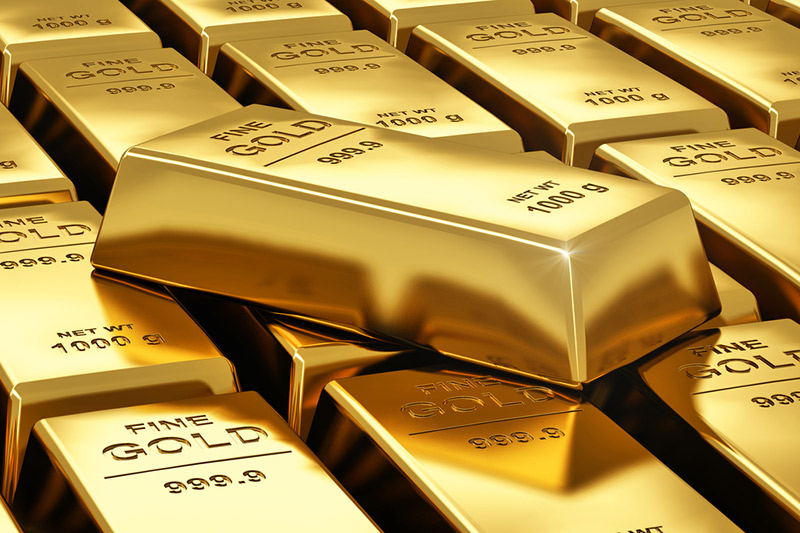Investing.com - Gold prices fell on Monday after investors concluded that even though monetary stimulus programs that have supported the precious metal in the past will stick around possibly for longer than anticipated, eventually, the Federal Reserve will begin winding down such policies likely this year.
Stimulus tools such as the Fed's USD85 billion in monthly bond purchases tend to weaken the dollar by driving down interest rates, making gold an attractive hedge.
Gold and the dollar tend to trade inversely from one another, and talk of the end of Fed stimulus measures softens the former while bolstering the latter.
On the Comex division of the New York Mercantile Exchange, gold futures for December delivery traded at USD1,392.50 during U.S. afternoon hours, down 0.24%.
Gold prices hit a session low of USD1,389.50 a troy ounce and high of USD1,406.50 a troy ounce.
Gold futures were likely to find support at USD1,351.90 a troy ounce, Tuesday's low, and resistance at USD1,423.25, the high from June 6.
The December contract settled up 1.82% at USD1,395.80 a troy ounce on Friday.
Weak U.S. economic reports sent gold prices spiking Friday and earlier on Monday until profit taking ended the rally.
The Commerce Department reported earlier Monday that U.S. durable goods orders dropped 7.3% in July, outpacing expectations for a 4.0% decline. The July figure marked the largest decline since August 2012.
Core durable goods orders, which are stripped of volatile transportation items, fell 0.6% last month, defying expectations for a 0.5% increase.
The numbers weakened the greenback earlier by keeping sentiments alive that the Federal Reserve won't rush to taper its USD85 billion in monthly bond purchases.
On Friday, the Commerce Department reported that new home sales in the U.S. dropped 13.4% to 394,000 units in July, far worse than market expectations for a 1.4% decline.
The dollar, however, regained strength as many market participants concluded that the Federal Reserve remains on track to begin tapering the pace of its asset purchases this year, and doubts surrounding a September start date or a December start date have already been priced into trading.
Elsewhere on the Comex, silver for December delivery was up 1.15% at USD24.055 a troy ounce, while copper for September delivery was down 0.79% and trading at USD3.330 a pound.
Stimulus tools such as the Fed's USD85 billion in monthly bond purchases tend to weaken the dollar by driving down interest rates, making gold an attractive hedge.
Gold and the dollar tend to trade inversely from one another, and talk of the end of Fed stimulus measures softens the former while bolstering the latter.
On the Comex division of the New York Mercantile Exchange, gold futures for December delivery traded at USD1,392.50 during U.S. afternoon hours, down 0.24%.
Gold prices hit a session low of USD1,389.50 a troy ounce and high of USD1,406.50 a troy ounce.
Gold futures were likely to find support at USD1,351.90 a troy ounce, Tuesday's low, and resistance at USD1,423.25, the high from June 6.
The December contract settled up 1.82% at USD1,395.80 a troy ounce on Friday.
Weak U.S. economic reports sent gold prices spiking Friday and earlier on Monday until profit taking ended the rally.
The Commerce Department reported earlier Monday that U.S. durable goods orders dropped 7.3% in July, outpacing expectations for a 4.0% decline. The July figure marked the largest decline since August 2012.
Core durable goods orders, which are stripped of volatile transportation items, fell 0.6% last month, defying expectations for a 0.5% increase.
The numbers weakened the greenback earlier by keeping sentiments alive that the Federal Reserve won't rush to taper its USD85 billion in monthly bond purchases.
On Friday, the Commerce Department reported that new home sales in the U.S. dropped 13.4% to 394,000 units in July, far worse than market expectations for a 1.4% decline.
The dollar, however, regained strength as many market participants concluded that the Federal Reserve remains on track to begin tapering the pace of its asset purchases this year, and doubts surrounding a September start date or a December start date have already been priced into trading.
Elsewhere on the Comex, silver for December delivery was up 1.15% at USD24.055 a troy ounce, while copper for September delivery was down 0.79% and trading at USD3.330 a pound.
